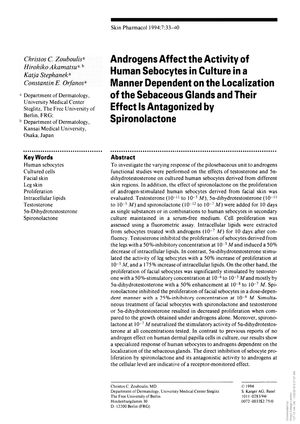Androgens Affect the Activity of Human Sebocytes in Culture in a Manner Dependent on the Localization of the Sebaceous Glands and Their Effect Is Antagonized by Spironolactone
January 1994
in “
Skin Pharmacology and Physiology
”

TLDR Male hormones affect oil-producing skin cells differently based on their body location, and the drug spironolactone can reduce these effects.
In a 1994 study, researchers discovered that androgens (testosterone and 5α-dihydrotestosterone) affect the activity of human sebocytes differently based on their location, with facial sebocytes showing increased proliferation in response to both androgens, particularly 5α-dihydrotestosterone, while leg sebocytes experienced inhibited proliferation and decreased lipid production in response to testosterone. The antiandrogen spironolactone was found to inhibit the proliferation of facial sebocytes in a dose-dependent manner, suggesting its potential to counteract androgen effects. The study involved sebocytes from five young individuals aged between 20 and 23, including three males and two females, but the small sample size limited the ability to draw gender-specific conclusions. These findings highlight the role of sebocyte activity in skin conditions like acne and possibly in hair loss disorders.
View this study on karger.com →
Discuss this study in the Community →